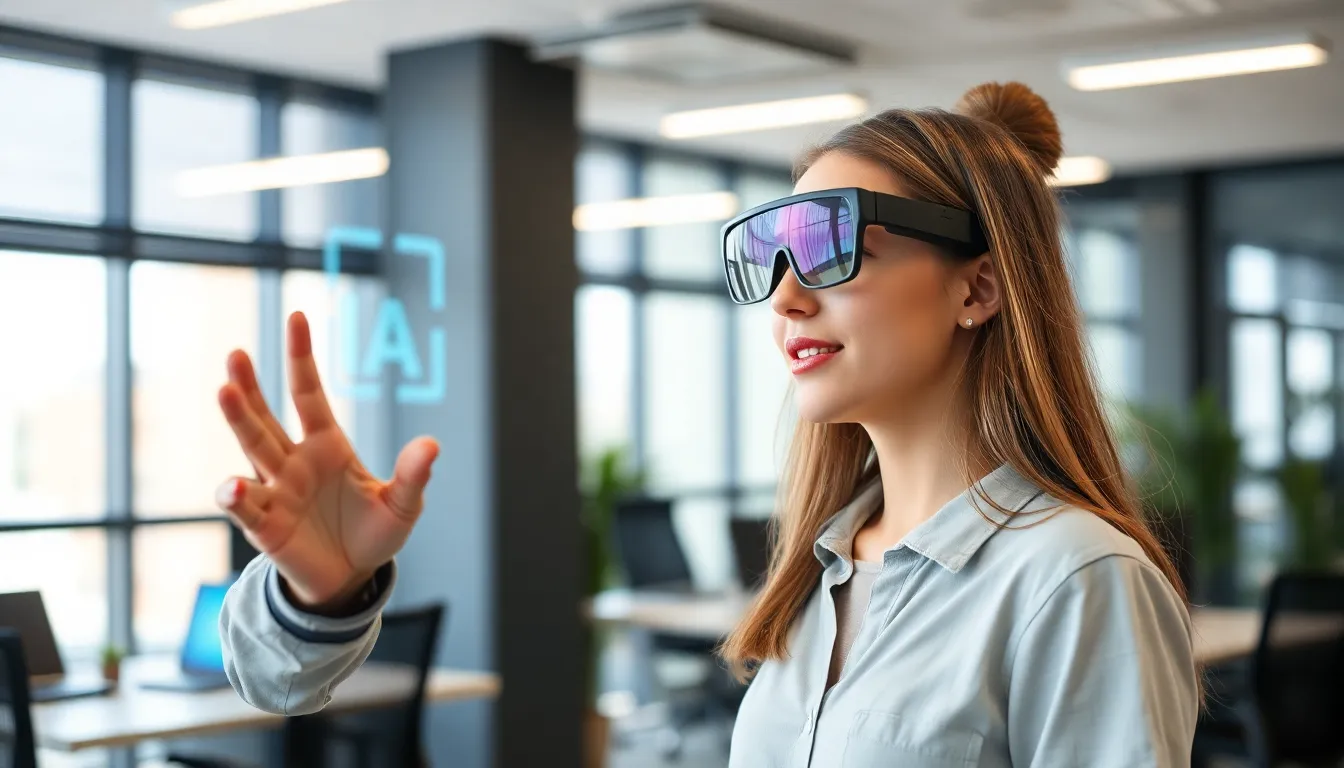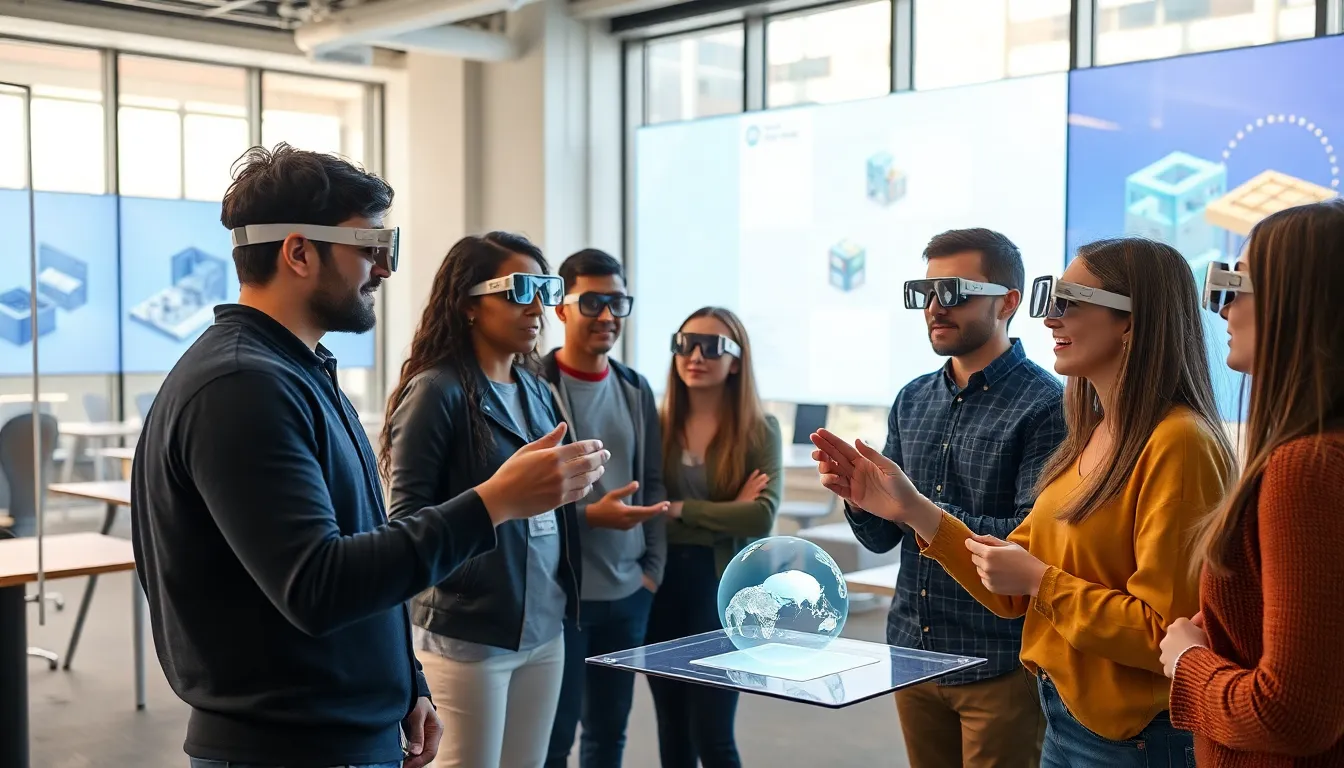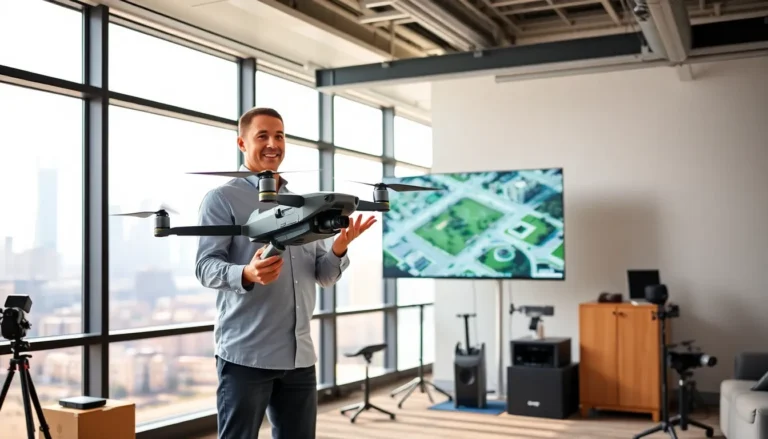Imagine stepping into a world where the ordinary becomes extraordinary. Augmented reality production is that magical doorway, blending digital elements with the real world in ways that make even the most mundane tasks feel like an adventure. From interactive marketing campaigns to immersive training simulations, AR is transforming how businesses engage with their audiences, leaving traditional methods in the dust.
But wait—this isn’t just about flashy graphics and cool gadgets. It’s about creating experiences that captivate and connect. Whether it’s a virtual fitting room that helps you dodge fashion faux pas or a game that turns your living room into a battlefield, augmented reality is the secret sauce for innovation. So buckle up, because diving into the world of AR production is not just a trend; it’s a ticket to the future of creativity and engagement.
Table of Contents
ToggleOverview of Augmented Reality Production
Augmented reality production integrates digital content into the physical world, enhancing experiences. It operates through devices such as smartphones, tablets, and smart glasses. Interactive applications demonstrate AR’s potential in various fields, including retail, gaming, and education.
Production involves several key elements. First, content creation plays a vital role. Designers develop 3D models, animations, and simulations to captivate users. Second, software development supports functionality. AR platforms like Unity and Vuforia enable seamless interactions between digital and physical realms.
User experience remains central to AR production. Intuitive interfaces ensure easy navigation and engagement with digital content. Feedback mechanisms enhance interactivity, reinforcing connections. This prioritization of usability leads to higher satisfaction rates among users.
Real-world applications of augmented reality highlight its versatility. Retail brands employ AR for virtual try-ons, allowing consumers to visualize products before purchase. Educational institutions utilize AR to create immersive learning environments, enhancing comprehension through interactive simulations.
Measurable benefits accompany AR adoption. Studies indicate increased customer engagement and improved retention rates. Businesses leveraging AR experience higher conversion rates, making it a strategic tool for marketing.
With advancements in technology, augmented reality production continues to evolve. Improved hardware capabilities and software innovations drive new possibilities. As industries embrace AR, the potential for innovative applications expands, promising exciting developments.
Key Technologies in Augmented Reality Production

Augmented reality production relies on various technologies that enhance user experiences and integration of digital content.
Software Tools
Software tools play a crucial role in AR production. Platforms like Unity offer robust frameworks for developing interactive experiences. Vuforia simplifies image recognition and tracking, enabling seamless incorporation of digital assets. Other tools, such as ARKit and ARCore, provide essential features for creating mobile-centric AR applications. Development environments often include features for testing and optimization to ensure top performance. Analytics software tracks user interaction, revealing insights that guide improvements in design.
Hardware Requirements
Hardware requirements form the backbone of effective AR production. Smartphones and tablets equipped with powerful processors and high-resolution cameras enable users to interact with AR content. Smart glasses, like Microsoft HoloLens, offer immersive experiences with hands-free capabilities. Graphics processing units (GPUs) enhance rendering performance, making dynamic interactions smooth. Sensors such as GPS, accelerometers, and depth cameras contribute to precise tracking and positioning in real environments. Connectivity options, including Wi-Fi and Bluetooth, facilitate real-time data streaming and sharing of AR experiences.
Applications of Augmented Reality Production
Augmented reality production finds significant applications across various sectors, enhancing user experiences and outcomes.
Education and Training
Innovative educational tools utilize AR to create immersive learning environments. Educators incorporate interactive elements that allow students to explore complex concepts visually. Medical training programs use AR simulations, enabling students to practice procedures in realistic settings. Corporate training sessions benefit from AR by providing employees hands-on experience in a controlled environment. Companies leveraging AR report improved knowledge retention and increased engagement among participants.
Entertainment and Gaming
AR transforms entertainment by blurring the lines between digital and physical worlds. Gaming experiences enhance user interaction through overlaying digital graphics in real environments. Popular mobile games engage users by encouraging them to explore neighborhoods while interacting with virtual elements. AR applications in live events create captivating experiences that redefine audience interaction. Examples include concerts featuring animated visuals or interactive storylines that evolve based on viewer participation.
Marketing and Advertising
Businesses leverage AR in marketing to create memorable brand interactions. Retailers employ virtual try-ons, enabling customers to visualize products before purchase. Campaigns increase customer engagement as consumers share their experiences on social media platforms. Brands like IKEA and Sephora have successfully integrated AR into their marketing strategies, showcasing their products in engaging ways. Integrated AR experiences lead to higher conversion rates, making marketing efforts more effective and memorable.
Challenges in Augmented Reality Production
Augmented reality production faces several significant challenges that can impact its effectiveness and user engagement.
Technical Limitations
Technical limitations hinder the full potential of augmented reality experiences. Hardware constraints often restrict the quality and complexity of AR applications. Device capabilities, such as processing power and battery life, play a vital role in performance. Furthermore, latency issues can disrupt the fluidity of interactions, leading to user frustration. Network connectivity also influences real-time data streaming. Weak connections may result in lag or disruptions during use. These factors can compromise the immersive nature AR aims to achieve.
User Experience Issues
User experience issues often arise from the complexity of AR applications. Overcomplicated interfaces can confuse users, detracting from engagement. Clarity in navigation is essential for seamless interaction. In addition, users may face difficulties in accurately interacting with virtual objects. Feedback mechanisms need to be intuitive to maintain interest. Limited accessibility for users with disabilities can create barriers to entry. Ensuring an inclusive experience remains a challenge for developers. Overall, prioritizing user experience is crucial for successful AR implementation.
Future Trends in Augmented Reality Production
Augmented reality production is poised for remarkable growth, driven by advancements in technology and increasing adoption across industries. Emerging trends include the integration of artificial intelligence, which enhances user interaction and personalization. Improvements in computer vision allow for more accurate recognition of real-world environments, creating seamless experiences. Consumer demand for interactive content continues to rise, prompting brands to invest in innovative AR solutions.
An increasing number of companies include remote collaboration tools in their AR strategies. Such tools facilitate teamwork by allowing employees and clients to interact in shared augmented environments. Enhanced devices also play a significant role, with smart glasses becoming more lightweight and affordable. This evolution leads to broader accessibility, providing more users with the ability to engage with AR experiences.
Personalization emerges as a crucial trend, with brands leveraging user data to create tailored interactions. These custom experiences not only enhance engagement but also improve conversion rates. Furthermore, the gaming industry drives much of the AR production innovation, showcasing experiences that blend the digital and physical worlds in unprecedented ways.
AR content creation tools continue to evolve, offering developers easier ways to produce sophisticated experiences. Platforms streamline the design process, enabling rapid prototyping and deployment of applications. The combination of these technologies supports a surge in immersive marketing campaigns as brands attempt to captivate their audiences.
Sustainable AR production practices are gaining attention alongside these technological advancements. An increasing focus on energy-efficient hardware and responsible content creation ensures that environmental considerations play a role in development. As augmented reality continues to mature, it becomes evident that these trends will shape the future landscape of AR production.
Augmented reality production is paving the way for a new era of creativity and engagement. As technology advances AR continues to redefine how businesses interact with their audiences. The potential applications across various sectors highlight its versatility and effectiveness in enhancing user experiences.
With a focus on user-centered design and innovative tools AR production is set to grow even further. Embracing this technology not only fosters meaningful connections but also drives measurable results. As industries adapt to these changes the future of AR promises to be both dynamic and impactful.





